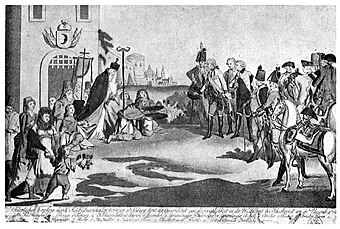Nicholas Mavrogenes
| Nicholas Mavrogenes | |
|---|---|
Prince of Wallachia | |
| Reign | 1786–1789 |
| Predecessor | Michael Drakos Soutzos |
| Successor | Michael Drakos Soutzos |
| Born | 1735 Paros |
| Died | 30 September 1790 Byala |
| House | Mavrogenis family |
| Religion | Orthodox |
Nicholas Mavrogenes (or Mavrogenous;
Early life and election
Mavrogenes was born on
Unlike other
Ruler of Wallachia

On 15 May 1786, Mavrogenes reached
Mavrogenes was also involved in the
Mavrogenes often
In the 1787 War
On 24 August 1787 the Ottomans declared war on the
As the city of Bucharest was spread over a large area and lacked any kind of fortifications, Mavrogenes decided to build some, including the digging of a moat from Cotroceni to Oborul Vechi, as well as reinforcing the walls of inns and monasteries (which were thus turned into crude fortresses). Unlike any other Phanariote ruler, he raised his own army, which reached 5–10,000 men and was equipped with several cannons,[1] but it was unruly and poorly trained. In addition, Mavrogenes asked for the Ottoman army to help him seal the border with Habsburg Transylvania and reinforce the borders with Moldavia.[10]
During that period, Mavrogenes used the services of Perdicari, an
On 21 November a Habsburg army of 20,000 men, located in the
On 9 February 1788, Joseph II, the Habsburg Holy Roman Emperor, declared war on the Ottoman Empire and started spreading manifestos in Wallachia which explained the war's purpose and promised to "free the Romanian people from the Turkish yoke". At that time, Mavrogenes' army had about 11,000 soldiers, and there was also an army of about 15,000 Turks assisting him. With these forces, he obtained a few victories in the battles of Târgu Jiu and Câmpulung, and was able to prevent a Habsburg invasion for about a year.[13]
These victories, together with the predictions astrologer made him confident in a victory and attacked Kronstadt from July to October 1788, but failed to take the city.[14] As the winter of 1788–1789 was harsh, no further military actions were carried out. After Abdul Hamid died in April, the new sultan, Selim III, gave Mavrogenes about 5–6,000 soldiers from Rumelia.[15]

In the meantime, the Russian army reported victories in Moldavia and rendezvoused with the Habsburg Army in
Mavrogenes fled Bucharest on 26 October, accompanied by an army of 1,000 men, after appointing
In June 1790, Mavrogenes, joined by a new Ottoman invading force, occupied the village of
Legacy and reputation

Mavrogenes remained a controversial figure, and historians' opinions about him are often contradictory. The Romanian
See also
Notes
- ^ a b c d e f g Giurescu, p.105
- ^ Ionescu, p.172-175
- ^ Djuvara, p.44
- ^ Ionescu, p.175
- ^ Giurescu, p.104-105; Ionescu, p.186
- ^ Djuvara, p.207
- ^ Ionescu, p.185-190
- ^ Ionescu, p.192-194
- ^ Ionescu, p.201
- ^ Ionescu, p.202-204
- ^ Ionescu, p.196
- ^ Ionescu, p.206-207
- ^ Ionescu, p.208; 210-211; 215
- ^ Ionescu, p.215-216
- ^ Ionescu, p.217
- ^ Ionescu, p.217-218
- ^ a b Giurescu, p.106
- ^ Ionescu, p.223
- ^ Ionescu, p.226-227
- ^ Ionescu, p.197
- Thomas Hope, Anastasius: Or, Memoirs of a Greek, downloadable at Google books
- ^ Ionescu, p.172
References
- Neagu Djuvara, Între Orient şi Occident. Ţările române la începutul epocii moderne ("Between Orient and Occident. The Romanian Lands at the beginning of the modern era"), Humanitas, Bucharest, 1995
- Constantin C. Giurescu, Istoria Bucureștilor. Din cele mai vechi timpuri pînă în zilele noastre ("History of Bucharest. From the earliest times until our day"), Ed. Pentru Literatură, Bucharest, 1966
- Ştefan Ionescu, Bucureștii în vremea fanarioţilor ("Bucharest in the time of the Phanariotes"), Editura Dacia, Cluj, 1974.
- Peter Mario Kreuter, Franz Leopold von Metzburg und Nicolae Mavrogheni. Momentaufnahmen einer schwierigen Beziehung zweier diplomatischer Welten. In: Encounters in Europe's Southeast. The Habsburg Empire and the Orthodox World in the Eighteenth and Nineteenth Centuries. Eds. Harald Heppner and Eva Posch. Verlag Dr. Dieter Winkler, Bochum, 2012, pp. 75–91.
